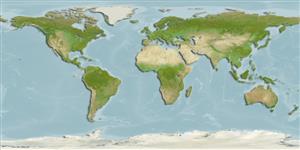Olocefali (chimere) (chimaeras) >
Chimaeriformes (Chimaeras) >
Chimaeridae (Shortnose chimaeras or ratfishes)
Etymology: Chimaera: Named for the mythological creature composed of parts of multiple animals, referring to their odd mix of characteristics. (See ETYFish); orientalis: Latin for eastern, the first Chimaera described from the eastern Pacific Ocean. (See ETYFish).
Environment: milieu / climate zone / depth range / distribution range
Ecologia
marino batidemersale; distribuzione batimetrica 560 - 1138 m (Ref. 97389). Deep-water
Distribuzione
Stati | Aree FAO | Ecosystems | Presenze | Point map | Introduzioni | Faunafri
Eastern Pacific: Costa Rica and Peru; probably more widely distributed in the eastern Pacifc region.
Size / Peso / Age
Maturity: Lm ? range ? - ? cm
Max length : 17.6 cm TL maschio/sesso non determinato; (Ref. 97389)
Short description
Morfologia | Morfometria
This species is distinguished from its congeners by having an anal fin; also by the following set of characters: the oral and preopercular canals share a short common branch off the infraorbital canal; long dorsal spine (DSA 28.4-31.0% BDL), longer than first dorsal fin, when depressed reaches beyond to origin of second dorsal fin; first dorsal fin is high (D1H 20.8-26.7% BDL) with a short base (D1B 10.3-12.5% BDL); long interdorsal space (IDS 8.1-10.2% BDL); long pectoral fin (P1A 40.0-43.5% BDL), when depressed reaches beyond origin of pelvic fin base; long pelvic claspers (CLT 17.5-17.7% BDL), bifurcate, divided at about distal 40.9-43.1% of its length; long dorsal caudal space (DCS 2.0-2.5% BDL); ventral caudal margin ending slightly posterior to dorsal caudal margin; coloration dark brown with ventral portion of the trunk and all fins slightly darker, without distinctive markings or mottling (Ref. 97389).
Life cycle and mating behavior
Maturità | Riproduzione | Deposizione | Uova | Fecundity | Larve
Angulo, A., M.I. López, W.A. Bussing and A. Murase, 2014. Records of chimaeroid fishes (Holocephali: Chimaeriformes) from the Pacific coast of Costa Rica, with the description of a new species of Chimera (Chimaeridae) from the eastern Pacific Ocean. Zootaxa 3861(6):554-574. (Ref. 97389)
IUCN Red List Status (Ref. 130435)
Threat to humans
Harmless
Human uses
Pesca:
Informazioni ulteriori
StatiAree FAOEcosystemsPresenzeIntroduzioniStocksEcologiaDietaPredeConsumo di ciboRazione
Nomi ComuniSinonimiMetabolismoPredatoriEcotossicologiaRiproduzioneMaturitàDeposizioneSpawning aggregationFecundityUovaEgg development
Age/SizeAccrescimentoLength-weightLength-lengthLength-frequenciesMorfometriaMorfologiaLarveDinamica popolazioni larvaliReclutamentoAbbondanzaBRUVS
BibliografiaAcquacolturaProfilo di acquacolturaVarietàGeneticaElectrophoresesEreditarietàMalattieElaborazioneNutrientsMass conversion
CollaboratoriImmaginiStamps, Coins Misc.SuoniCiguateraVelocitàModalità di nuotoArea branchialeOtolithsCervelliVista
Strumenti
Special reports
Download XML
Fonti Internet
Estimates based on models
Phylogenetic diversity index (Ref.
82804): PD
50 = 0.5000 [Uniqueness, from 0.5 = low to 2.0 = high].
Bayesian length-weight: a=0.00282 (0.00118 - 0.00673), b=3.10 (2.89 - 3.31), in cm total length, based on LWR estimates for this (Sub)family-body shape (Ref.
93245).
Trophic level (Ref.
69278): 3.4 ±0.5 se; based on size and trophs of closest relatives
Resilienza (Ref.
120179): Basso, tempo minimo di raddoppiamento della popolazione 4.5 - 14 anni (Deep-water species with low fecundity (RF).).
Fishing Vulnerability (Ref.
59153): Low vulnerability (10 of 100).
